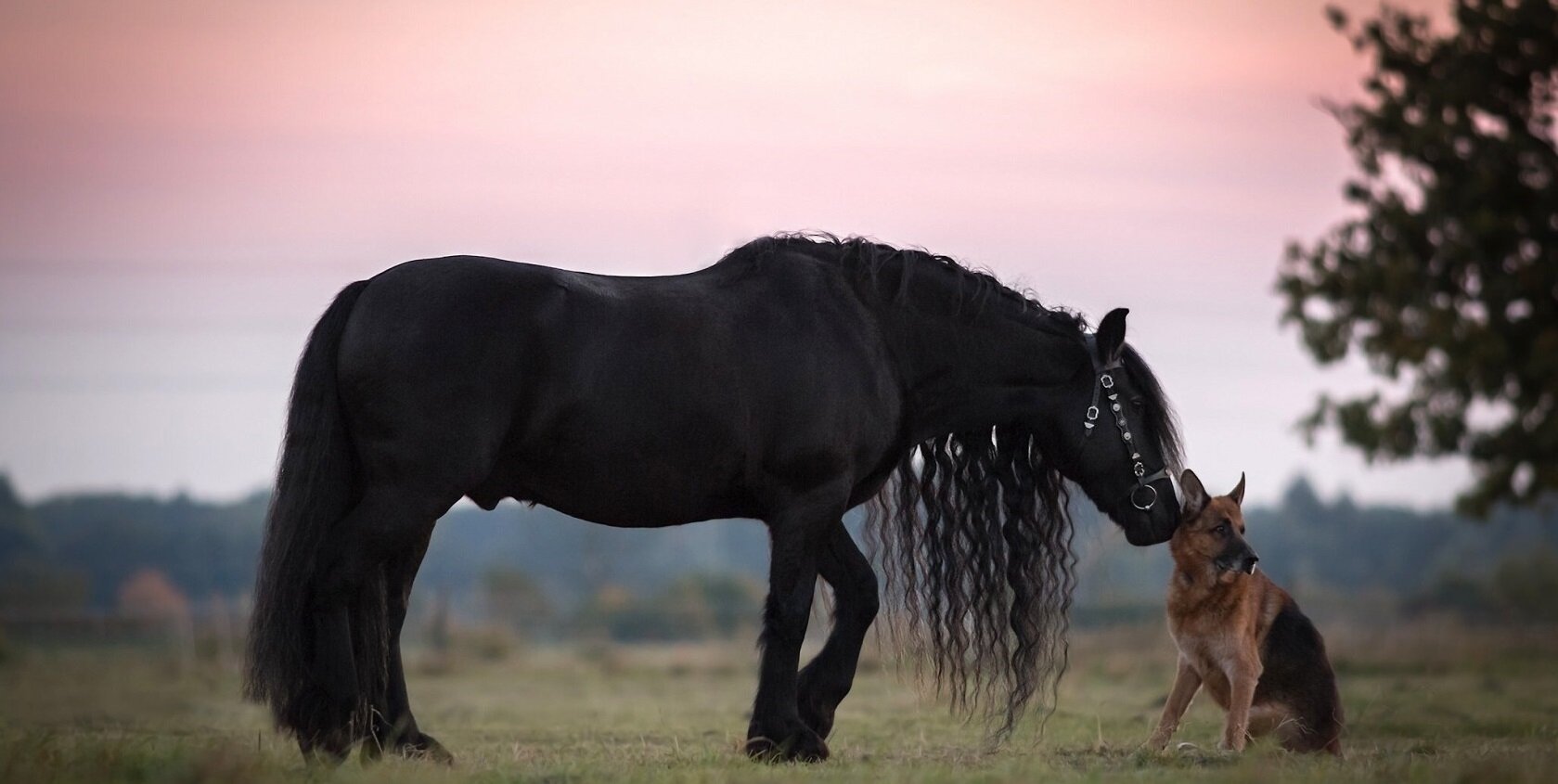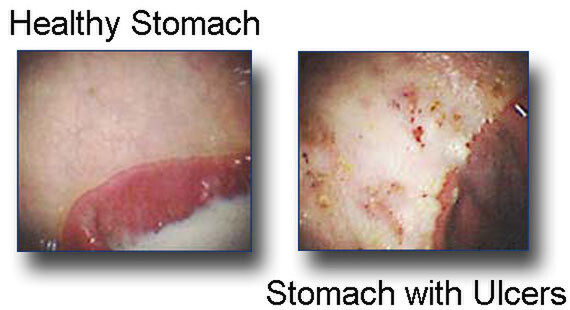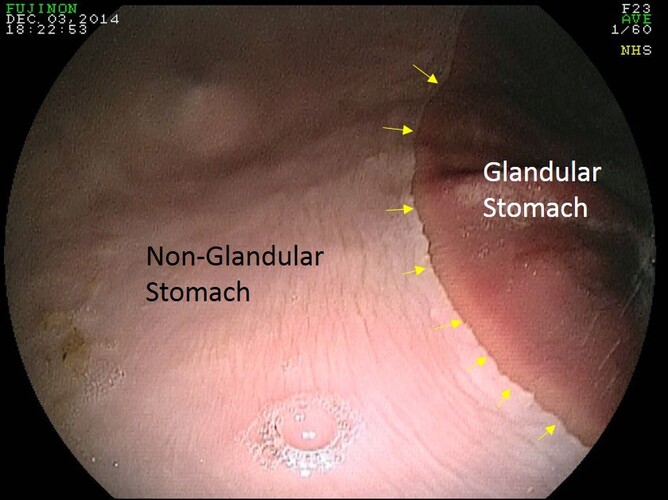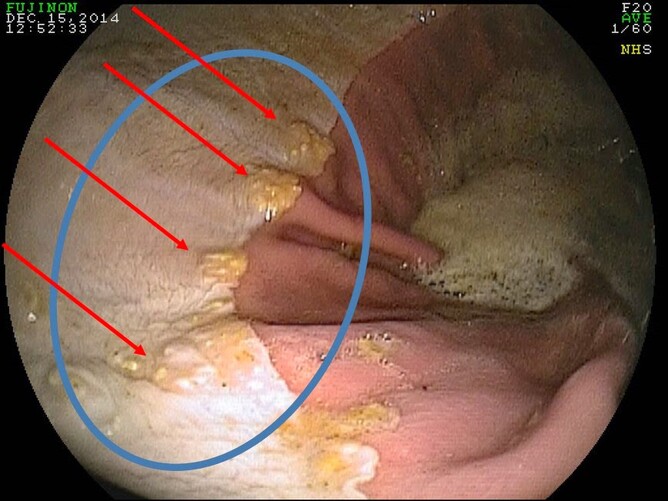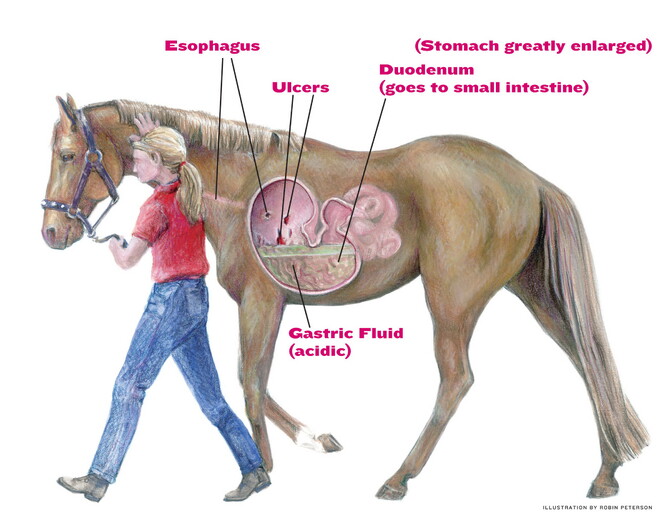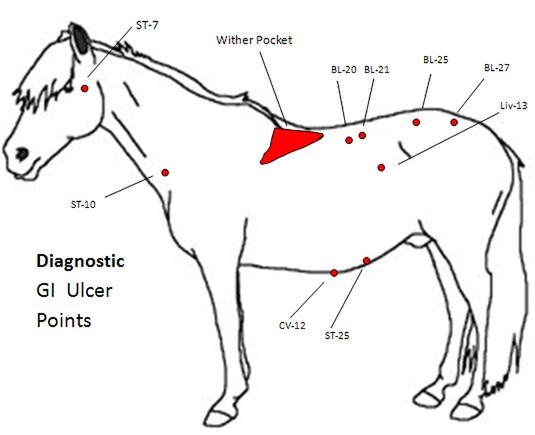As a therapist I regularly see horses with signs of ulcers. Acupuncture points for Horse's with Ulcers and Gut Pain. From an equine therapist point of view often after treatment these points are still sore or the pain goes but comes back.
This is due to gastric ulcers, Often the horse is sore on the right hind, may step short or have an odd gait and curves to the left side and pushes out through the right rib cage, the hind gut is on the right side.
When there is pain due to gut pain and ulcers the horse shows these symptoms and is very hard to remedy with only therapy. You may hear me going on and on about Gastric Ulcers, I don't think many people realise how much this effects the horse from inside to out. Fix the internal problem and with therapy you get a long lasting effect !
When faced with signs of ulcers in their horses, many clients are shocked. “My horse could not possibly be stressed. I give him a great life.” Sound familiar? Many people think they are doing what’s best for their horses, but despite their good intentions they’re often working with the wrong information.
Stomach linings x 2
Horses are meant to graze all day, which means they produce stomach acid 24/7. They can produce up to 16 gallons of acidic fluid every day. Horses’ stomachs also have two different linings:
- The glandular mucosa is a stronger protected lining at the bottom of the stomach where the acid sits. The glandular mucosa is where you will see ulcers from NSAID use/overuse due to decreased blood flow to the stomach lining.
- The squamous mucosa makes up the top half of the stomach and is a non-protected lining.
These two types of stomach lining meet at the margo plicatus. This is where you most often see the beginnings of stress ulcers; as they get more severe, they can cover the whole squamous mucosa.
EGUS in horses
Equine Gastric Ulcer Syndrome (EGUS) is a very common disease. As many as 93% of racehorses , 63% of competitive horses , 51% of foals and 71% of broodmares can have them. Some of the stressors causing ulcers are competition, travel, training, trailering, limited turnout or grazing, lay up, changes in routine, and changes in herd dynamics or facility.
Symptoms you will see in EGUS horses include changes in eating and drinking behavior, weight loss and poor hair coat (usually seen in long term cases), a change in attitude, recurrent mild colic, and decreased or poor performance. Foals will grind their teeth or lie on their backs. Stomach pain, back pain and cinchiness are also signs.
Two types of “ulcer horses”
- High energy and outwardly nervous horses tend to show their stress, whether through behavior, sweat, poor performance or other signs. 2. The silent sufferer is what is called the “internalizer”. These horses do not show signs or symptoms. They may simply have a poor hair coat, an inability to put on weight, or display a slight change in behavior.
The first step in treating stomach ulcers is helping to understand what EGUS is. Most owners are horrified and feel a lot of guilt when they find out their horse has stomach ulcers.
Find the source of stress
The next step to treating stomach ulcers is finding the source of stress and helping the horse cope with whatever he is being faced with. For example, an old retired horse was moved into a new pasture and started to go downhill quickly. He lost weight rapidly and his coat became dull. After a scope, he was diagnosed with severe ulcers. All it took for him to recover was a change in pasture with other horses that let him eat and were nice to him.
In another case, a horse was kicking at his sides and biting the air when he ate his grain every night. The grain turned out to be acidic and was producing excess stomach acid, which was irritating his stomach. By changing his feed, the kicking and biting went away.
Sometimes you cannot avoid the stress that causes ulcers, as in the case of performance horses. It is difficult, to ask elite equine athletes to perform at their optimum level when they are suffering from EGUS. For these horses, you will need to find a way to help them cope with the stress and treat the ulcers.
Treatment choices
There are many treatment options available for ulcers. Some are efficacious and some are not.
- The first option is rest. A horse’s stomach can heal itself. If he is removed from the stressful situation, he will usually heal within a month. The problem with this method is that most people do not want to turn their horses out for a month and lose that time for training or showing while they wait for the ulcers to heal.
- Many medications treat ulcers, including acid pump inhibitors, H2-antagonists, and antacids. They work to varying degrees, but the most important thing when using them is knowing how long the drug works in the system and remembering that a horse’s stomach produces acid 24 hours a day.
- There are also many natural approaches: slippery elm, aloe vera juice, licorice, papaya and more. Very little or no research has been done on the effectiveness of these treatments. Most of the information has been anecdotal.
Recent research on the super antioxidant l’ergothioneine derived from medicinal mushrooms has established that it is the only antioxidant with a cellular transport mechanism. This mechanism senses inflammation and transports l’ergothioneine into the cell to reduce free radical activity.
Prevention tactics
The last step to treating stomach ulcers is preventing them. This is a step most people forget or ignore. Just because the ulcers have been treated and healed, it doesn’t mean they won’t come back as soon as the horse is reintroduced to the stress that caused them in the first place.
“A horse that is stressed for any reason (prolonged transport, systemic illness, major husbandry change, etc.), particularly one that has been stressed, is an ulcerated stomach waiting to happen. “Keeping these horses eating, decreasing stress as much as possible, and being proactive in prevention are key.”
Reducing stress and using natural solutions like probiotics and etc. will provide the horse with a well rounded prevention plan. Other ways to help prevent stomach ulcers include having a full hay net with small feeding holes available to the horse at all times, to promote “grazing” at a slower pace rather than large hole haynets, or feeding him more frequently during the day.
When exercising horses it is good for food some roughage to be present in the stomach to help blunt the effects of acid getting pushed up and onto the unprotected squamous porting of the stomach. It cannot be emphasized enough times to do your best to feed small amounts frequently.
Without prevention or removing horses from stressors, the patients that have been treated with therapy and gastric gaurd will get ulcers again.
As Dr. Kerry Ridgeway has expressed, We should all recognize that gastric and intestinal ulcers are literally a slow or non-healing acid burn - a burn such as if hydrochloric acid was splashed on your face. The horse’s ulcers are a combination of this hydrochloric acid, as well as volatile fatty acids and bile acids. In horses, the acid burns holes into the lining of the stomach, small or large bowel.
The acids may burn a crater deeply enough to cause bleeding or even burn through and penetrate the gut. When the acid burn craters do heal they can create scar tissue and strictures, especially in the small intestine that may lead to colic.
When horses develop painful and restricted movement associated with excess muscle tension, and poor ability to use the spine – resulting in pain - they cannot perform at the desired level. They are, thus, more prone to injury if pushed to jump higher, run faster, suddenly change direction, etc. In the case of cross country eventing, show jumping, racing, cutting and etc.
Very importantly but not as commonly realized, as it should be, body pain goes hand in with ulcers. Whether arising from muscles, skeletal problems or from joints, pain is inextricably associated with impaired performance. The form that the issue takes is, of course, variable, but may include reluctance to jump in good form, running out, bucking or refusals. It is not uncommon for the horse to buck after a jump.
Similarly horses may be reluctant to go down hill. In such cases (including the horse landing after a jump), when the stomach has been compressed by the abdominal contents the acids in the stomach are splashed up and onto the non-glandular portion. This portion of the stomach is more susceptible to acid damage than the glandular portion (that portion secreting the acid.) Performance horses, for example may refuse to take a specific lead or to perform a rollback or pirouette, slide, etc.
Due to the consistent muscle pain patterns found in ulcer cases, the horse will cross canter or refuse to pick up a specific lead. Often these horses do not come through in the hindquarters (especially the right hind).
They are often restricted in the shoulders due to a consistently found neuromuscular pattern that tightens the fascia over the muscles of the shoulder and wither pocket area.
This myofascial contracture limits the ability of the muscles to lengthen and shorten appropriately. The result is pain and develops into a consistent pattern of vertebral dysfunction in the wither vertebrae. Other consistent findings include chiropractic issues in the thoraco-lumbar area (the transition zone from chest vertebrae to the loin vertebrae).
There is also a consistent pattern of pain and dysfunction where the lumbar vertebra joints articulate with the sacrum. Vertebral joint dysfunction is defined, basically, as an inability of joints to move through their full range of motion. Loss of joint motion results in pain and inability to use the back well.
One very important muscle that is frequently dysfunctional in ulcer cases is the Psoas (pronounced “SO-as and is actually a group of 3 muscles). Taken together, this group represents one of the largest and strongest muscles in the body. Its function is to stabilize and protect the pelvic girdle from damage.
This is the group of muscles that prevents a racehorse from literally fracturing its pelvis when it bolts from the starting gate. The Psoas muscles are usually intimately involved in chronic sore backs in both horses and people.
When there is Psoas muscle pain the pelvis and croup muscles cannot function well. The croup muscles then go into spasm and are painful to palpation (touch). Understanding this, it is easy to visualize significant loss of performance ability.
What can you observe when you look at a horse with ulcer problems?
- Weight Loss: That, of course, depends on the severity and duration of the ulcers. However, even in somewhat less severe cases horses are moderately down in weight. Recent history often indicates that it is hard to keep weight on them. Hand in hand the horse may show some loss of muscle mass and top line.
2. Eating Patterns: In observing the ulcer horse’s eating patterns, you may notice that it has become a slow or picky eater. Some will literally walk away from their hay and/or grain. It is common that they may nibble hay, but refuse grain. (Some horses with ulcers will continue to eat like a proverbial pig)
3. Appearance: It is also commonly observed that the hair coat, especially, over the thorax (chest) is duller than on the neck or hindquarters. (not every horse will show this pattern)
4. Resistance to Grooming: Many horses with ulcers do not like to be brushed on the bottom of the chest and abdomen. They may even kick out if touched in the area of the sheath or mammary glands.
5. It is very important to note that some horses may be in good flesh, have good appetites and still have ulcers in their digestive tracts and have musculo/skeletal issues and performance related problems that are consistent with the ulcers.
6. Horses with chronic ulcers may show poor quality feet.
The more time the stomach has food within it, the more it will properly stimulate the gut and use that amazing amount of acid production for the digestive process. With that in mind, whether at home or on the road, keep him eating small amounts of food as frequently as possible. Hay bags with small openings such as the “Nibblenet”.
At home the ideal, of course, is free access to pasture or forage. For those horses who “pig out” one can always use a grazing muzzle that makes them work for every blade. Also instead of feeding a bunch of hay in one pile, scatter it all over the paddock so that he moves and picks and moves and picks.
Using Acupuncture helps with ulcer treatment but it ideally works best to fix the problem internally and treat all muscoskeletal issues to keep him supple and on peak performance.
